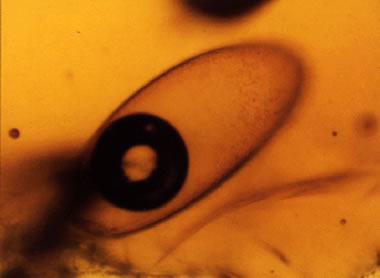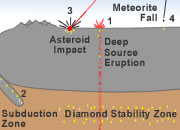Home » General Geology » Amber and Atmospheric Chemistry
Amber Yields Clues to the History of Oxygen in Earth's Atmosphere
Gas bubbles trapped in amber show an oxygen-rich Cretaceous atmosphere
Republished from a information release posted by USGS in June 2009.

Mosquito trapped in amber: Amber - the fossilized resin of conifer trees - provides a unique means of protecting intricate samples of the past. This mosquito, lying trapped for 45 million years in a piece of amber, is almost perfectly preserved. USGS image.
Compositional History of Earth's Atmosphere
Ages of ice samples found on the Earth cover a span approaching 200,000 years. Gas bubbles trapped in that ice can be used to learn about the composition of Earth's atmosphere at the time they were trapped in the ice. But how can we tell what the Earth's atmosphere was like before that?
Recently, USGS scientists have used a gas QMS to determine the oxygen level of ancient samples of Earth's atmosphere from a most unlikely place - amber. The fossilized resin of conifer trees, amber is interesting to scientists as a medium that traps insects, small animals, and plants, preserving them through geologic time for future study.
The recent extraction by scientists, of ancient DNA from organisms entombed in amber much like in the science-fiction novel and movie, Jurassic Park is an example of why scientists are intensely interested in amber. Minute bubbles of ancient air trapped by successive flows of tree resin during the life of the tree are preserved in the amber.

Oxygen levels over time: This chart shows a major decrease in oxygen content in the atmosphere from 35 percent to the present day level of 21 percent. This decrease occurred about the same time that the dinosaurs disappeared - 65 million years ago. USGS image.
The Oxygen-Rich Cretaceous Atmosphere
Analyses of the gases in these bubbles show that the Earth's atmosphere, 67 million years ago, contained nearly 35 percent oxygen compared to present levels of 21 percent. Results are based upon more than 300 analyses by USGS scientists of Cretaceous, Tertiary, and recent-age amber from 16 world sites. The oldest amber in this study is about 130 million years old.

Air bubble trapped in amber: This 84-million-year-old air bubble lies trapped in amber (fossilized tree sap). Using a quadrupole mass spectrometer, scientists can learn what the atmosphere was like when the dinosaurs roamed the earth. USGS image.
Significance of Cretaceous Oxygen Levels?
The consequences of an elevated oxygen level during Cretaceous time are speculative. Did the higher oxygen support the now extinct dinosaurs? Their demise was gradual in the transition from late Cretaceous to early Tertiary times, as was the decrease in oxygen content of the atmosphere.
Citations
Landis, G.P., Rigby, J.K.,Jr., Sloan, R.E., Hengst, R.A., and Snee, L.W., 1996, Pelé Hypothesis: Ancient atmospheres and geologic-geochemical controls on evolution, survival, and extinction, in G. Keller and N. MacLeod, eds., Cretaceous-Tertiary Mass Extinctions. Biotic and Environmental Changes, W.W. Norton, pp. 519-556.
Landis, G.P., and Snee, L.W., 1991, 40Ar/39Ar Systematics and argon diffusion in Amber; implications for ancient earth atmospheres: in Kump, L.R., Kasting, J.F., Robinson, J.M., Atmospheric oxygen variation through geologic time. Global and Planetary Change. v. 5, p.63-67.
| More General Geology |
 |
Diamonds from Coal? |
 |
What is a Geyser? |
 |
What is the San Andreas Fault? |
 |
Igneous and Volcanic Features |
 |
The Doorway to Hell |
 |
Topo Maps |
 |
Geology Dictionary |
 |
Gifts That Rock |

Find Other Topics on Geology.com:

|

| ||

|

| ||

|

| ||

|

|
